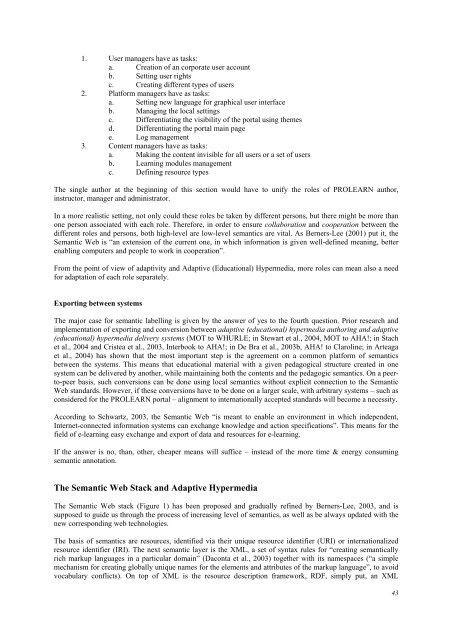Ontologies and the Semantic Web for E-learning - Educational ...
Ontologies and the Semantic Web for E-learning - Educational ...
Ontologies and the Semantic Web for E-learning - Educational ...
You also want an ePaper? Increase the reach of your titles
YUMPU automatically turns print PDFs into web optimized ePapers that Google loves.
1. User managers have as tasks:<br />
a. Creation of an corporate user account<br />
b. Setting user rights<br />
c. Creating different types of users<br />
2. Plat<strong>for</strong>m managers have as tasks:<br />
a. Setting new language <strong>for</strong> graphical user interface<br />
b. Managing <strong>the</strong> local settings<br />
c. Differentiating <strong>the</strong> visibility of <strong>the</strong> portal using <strong>the</strong>mes<br />
d. Differentiating <strong>the</strong> portal main page<br />
e. Log management<br />
3. Content managers have as tasks:<br />
a. Making <strong>the</strong> content invisible <strong>for</strong> all users or a set of users<br />
b. Learning modules management<br />
c. Defining resource types<br />
The single author at <strong>the</strong> beginning of this section would have to unify <strong>the</strong> roles of PROLEARN author,<br />
instructor, manager <strong>and</strong> administrator.<br />
In a more realistic setting, not only could <strong>the</strong>se roles be taken by different persons, but <strong>the</strong>re might be more than<br />
one person associated with each role. There<strong>for</strong>e, in order to ensure collaboration <strong>and</strong> cooperation between <strong>the</strong><br />
different roles <strong>and</strong> persons, both high-level are low-level semantics are vital. As Berners-Lee (2001) put it, <strong>the</strong><br />
<strong>Semantic</strong> <strong>Web</strong> is “an extension of <strong>the</strong> current one, in which in<strong>for</strong>mation is given well-defined meaning, better<br />
enabling computers <strong>and</strong> people to work in cooperation”.<br />
From <strong>the</strong> point of view of adaptivity <strong>and</strong> Adaptive (<strong>Educational</strong>) Hypermedia, more roles can mean also a need<br />
<strong>for</strong> adaptation of each role separately.<br />
Exporting between systems<br />
The major case <strong>for</strong> semantic labelling is given by <strong>the</strong> answer of yes to <strong>the</strong> fourth question. Prior research <strong>and</strong><br />
implementation of exporting <strong>and</strong> conversion between adaptive (educational) hypermedia authoring <strong>and</strong> adaptive<br />
(educational) hypermedia delivery systems (MOT to WHURLE; in Stewart et al., 2004, MOT to AHA!; in Stach<br />
et al., 2004 <strong>and</strong> Cristea et al., 2003, Interbook to AHA!; in De Bra et al., 2003b, AHA! to Claroline; in Arteaga<br />
et al., 2004) has shown that <strong>the</strong> most important step is <strong>the</strong> agreement on a common plat<strong>for</strong>m of semantics<br />
between <strong>the</strong> systems. This means that educational material with a given pedagogical structure created in one<br />
system can be delivered by ano<strong>the</strong>r, while maintaining both <strong>the</strong> contents <strong>and</strong> <strong>the</strong> pedagogic semantics. On a peerto-peer<br />
basis, such conversions can be done using local semantics without explicit connection to <strong>the</strong> <strong>Semantic</strong><br />
<strong>Web</strong> st<strong>and</strong>ards. However, if <strong>the</strong>se conversions have to be done on a larger scale, with arbitrary systems – such as<br />
considered <strong>for</strong> <strong>the</strong> PROLEARN portal – alignment to internationally accepted st<strong>and</strong>ards will become a necessity.<br />
According to Schwartz, 2003, <strong>the</strong> <strong>Semantic</strong> <strong>Web</strong> “is meant to enable an environment in which independent,<br />
Internet-connected in<strong>for</strong>mation systems can exchange knowledge <strong>and</strong> action specifications”. This means <strong>for</strong> <strong>the</strong><br />
field of e-<strong>learning</strong> easy exchange <strong>and</strong> export of data <strong>and</strong> resources <strong>for</strong> e-<strong>learning</strong>.<br />
If <strong>the</strong> answer is no, than, o<strong>the</strong>r, cheaper means will suffice – instead of <strong>the</strong> more time & energy consuming<br />
semantic annotation.<br />
The <strong>Semantic</strong> <strong>Web</strong> Stack <strong>and</strong> Adaptive Hypermedia<br />
The <strong>Semantic</strong> <strong>Web</strong> stack (Figure 1) has been proposed <strong>and</strong> gradually refined by Berners-Lee, 2003, <strong>and</strong> is<br />
supposed to guide us through <strong>the</strong> process of increasing level of semantics, as well as be always updated with <strong>the</strong><br />
new corresponding web technologies.<br />
The basis of semantics are resources, identified via <strong>the</strong>ir unique resource identifier (URI) or internationalized<br />
resource identifier (IRI). The next semantic layer is <strong>the</strong> XML, a set of syntax rules <strong>for</strong> “creating semantically<br />
rich markup languages in a particular domain” (Daconta et al., 2003) toge<strong>the</strong>r with its namespaces (“a simple<br />
mechanism <strong>for</strong> creating globally unique names <strong>for</strong> <strong>the</strong> elements <strong>and</strong> attributes of <strong>the</strong> markup language”, to avoid<br />
vocabulary conflicts). On top of XML is <strong>the</strong> resource description framework, RDF, simply put, an XML<br />
43
















